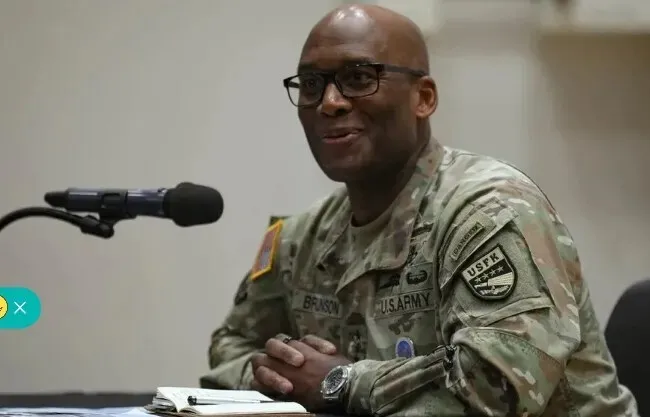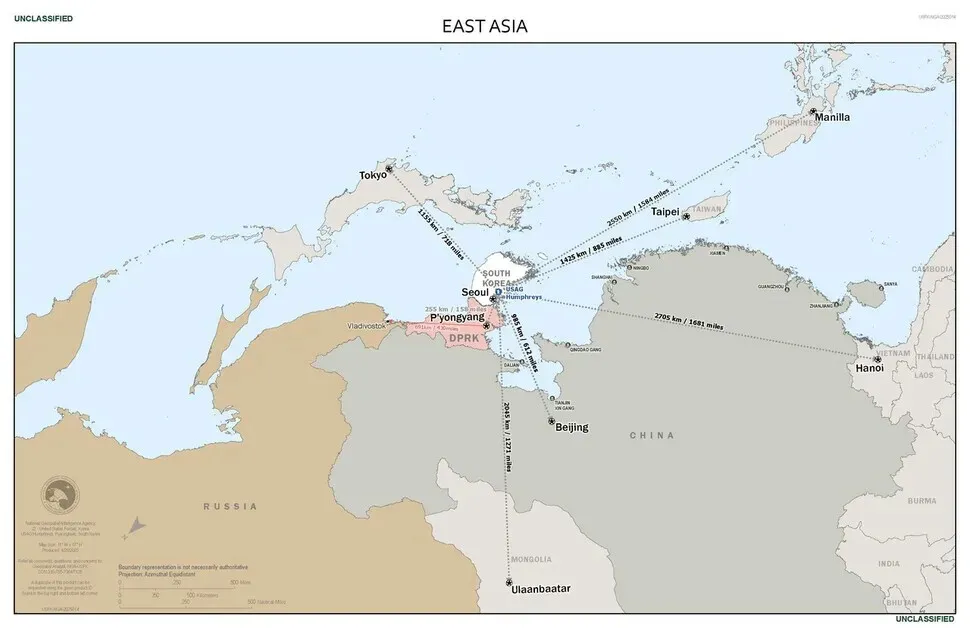The “east-up” map of East Asia that’s getting used for inner academic functions by US Forces Korea. (courtesy of USFK)
Gen. Xavier Brunson, the commander of US Forces Korea, introduced an upside-down map of East Asia to emphasize the function of USFK and the strategic worth of the Korean Peninsula in deterring China and Russia.
In a column revealed on the USFK web site on Sunday, Brunson argued that the so-called “east-up” map illustrated the potential of cooperation amongst Korea, Japan and the Philippines, in addition to the strategic location of South Korea.
“Korea supplies strategic depth and central positioning throughout the regional structure, with the added benefit of cost-imposition capabilities in opposition to each Russian and Chinese language forces,” Brunson argued.
The map reveals the USFK Command at Camp Humphreys in Pyeongtaek, Gyeonggi Province. The map reveals the linear distance from Camp Humphreys to Taipei (1,425 km), Manila (2,550 km), Beijing (985 km), Tokyo (1,155 km), Pyongyang (255 km), and Vladivostok (805 km).
The inverted map demonstrates Brunson’s plans for USFK to evolve from a hard and fast place on the Korean Peninsula particularly tasked with deterring North Korea to a drive that may be strategically deployed all through China and East Asia at giant. The map was produced on the orders of Brunson, who was appointed as commander over US troops within the nation final yr, and is now used for academic functions throughout the USFK.
In his column, Brunson refers back to the first island chain — a digital line linking Japan’s Kyushu Island, Okinawa, Taiwan and the Philippines that acts as each China’s first maritime line of protection and the US’ blockade line in opposition to China — whereas remarking on the strategic place of Korea.
“Forces already positioned on the Korean Peninsula are revealed not as distant property requiring reinforcement, however as troops already positioned contained in the bubble perimeter that the US would wish to penetrate within the occasion of disaster or contingency,” Brunson stated.
Brunson additional confused that the placement of the Korean Peninsula permits it to restrict the eastward development of the Russian fleet and complicate the Chinese language navy and armed forces’s actions within the waters off Korea’s western coast.

Gen. Xavier Brunson, the commander of US Forces Korea, speaks to reporters throughout a press convention at Camp Humphreys in Pyeongtaek, on Aug. 8, 2025. (courtesy of USFK)
When seen from Beijing’s perspective, US forces at Osan Air Base “seem not as distant threats requiring complicated energy projection, however as instantly proximate capabilities positioned to attain results in or round China,” Brunson wrote.
He additionally emphasised the strategic worth of South Korea’s “trilateral cooperation” with Japan and the Philippines.
“Most importantly,” Brunson argued, “[the map] illuminates the potential of the Korea-Japan-Philippines strategic triangle as a framework for enhanced alliance cooperation, whereas demonstrating the rapid cost-imposition capabilities that present drive positioning already supplies.”
“Korea supplies strategic depth and central positioning throughout the regional structure, with the added benefit of cost-imposition capabilities in opposition to each Russian and Chinese language forces,” he defined. “Japan contributes superior technological capabilities and controls crucial maritime chokepoints alongside the Pacific delivery lanes. The Philippines provides southern entry factors and management over very important sea lanes connecting the Pacific and Indian Oceans.”
In response to a written inquiry from a protection reporter about whether or not this framework was geared toward constructing a collective protection posture to discourage China, Brunson stated, “This isn’t about forming a brand new alliance, nor about any single nation. It’s about recognizing geographic relationships that exist already and discovering sensible methods to coordinate.”
By Kwon Hyuk-chul, workers reporter
Please direct questions or feedback to [english@hani.co.kr]

